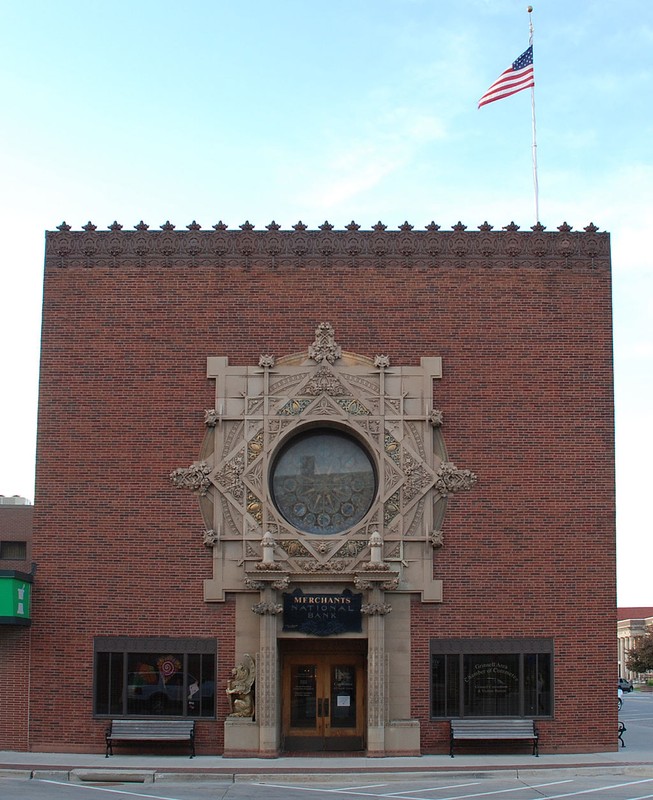Merchants' National Bank
Introduction
Text-to-speech Audio
Grinnell's Merchants' National Bank building is one of the most unique architectural landmarks in central Iowa. The structure is one of the three surviving "jewel box" banks in the Midwest designed by noted American architect Louis Sullivan (1856-1924), who is known as the "father of skyscrapers." The bank was built in 1914 and, despite its boxy shape, features a number of ornate decorative elements. The most notable of these is the large, stained glass rose window on the front facade surrounded by an elaborate terra cotta "sunburst". The main entrance is surrounded by a decorative frame and flanked by two winged lions holding a shield. The east facade features a large, recessed stained glass window with columns. The cornice is made of decorative terra cotta features finials. The former bank is now home to the Grinnell Chamber of Commerce and the Grinnell Visitor Center.
Images
A National Historic Landmark, the Merchants' National Bank was designed by famed American architect Louis Sullivan. It was built in 1914 and features elaborate ornamentation, which was a hallmark of Sullivan's work.

Backstory and Context
Text-to-speech Audio
Louis Sullivan
Louis Sullivan was born on September 3, 1856 in Boston to an Irish father and Swiss mother, both of whom immigrated to the United States in the late 1840s. Sullivan attended the Massachusetts Institute of Technology where he studied architecture. However, he only stayed for one year and found a job at a Philadelphia architecture firm. After working for a few months, he moved to Chicago in 1873. Less than a year later, he moved to Paris, France and studied at the famed École des Beaux-Arts school for a year. Sullivan returned to Chicago and found a job as a draftsman. A turning point in his young career came in 1879 when architect Dankmar Adler hired him. They primarily designed auditoriums, the most notable of which was the Chicago Theater. It was also in Chicago where Sullivan created a new style for tall buildings, which consists of a base, shaft, and a prominent cornice to emphasized verticality. Sullivan also incorporated vertical bands and his own floral designs.
In his later years, Sullivan's prominence decreased. The popularity of neo-historical styles, such as the Beaux-Arts style, had risen after they were used in many of the buildings at the Chicago World's Fair in 1893 (the economic depression that began that year also cut the number of commissions he received). He and Adler ended their partnership in 1895 due to disagreements. Sullivan became reclusive, lonely and he struggled financially. His marriage to a woman named Margaret Davies Hattabough in 1899 only lasted until 1906 (they did not have children).
Merchants' National Bank
The eight bank commissions were among Sullivan's last projects. The other two that remain are in Owatonna, Minnesota and Cedar Rapids, Iowa. The Grinnell bank, which opened on January 1, 1915, has been largely unaltered. In 1976, an addition was built on the north side that houses a Wells Fargo Bank branch. The original part of the building was used as bank until 1999 when the Chamber of Commerce acquired it. Inside the building features terra cotta ornamentation, a handmade wooden check-writing table, and pink Tennessee marble floors. Merchants' National Bank is a National Historic Landmark and is listed on the National Register of Historic Places. It a popular site for visitors.
Sources
Koeper, H.F. "Louis Sullivan". Encyclopedia Britannica. August 30, 2021. https://www.britannica.com/biography/Louis-Sullivan.
"Merchants' National Bank" (pdf). Grinnell Convention and Visitors Bureau. Accessed February 15, 2022. https://www.grinnelliowa.gov/DocumentCenter/View/835/Sullivans-Jewel-Box?bidId=.
Pitts, Carolyn. "Merchants' National Bank." National Park Service - National Register of Historic Places Nomination Form. January 7, 1976. https://npgallery.nps.gov/NRHP/GetAsset/NHLS/76000804_text.
Wikimedia Commons: https://commons.wikimedia.org/wiki/Category:Merchants%27_National_Bank
